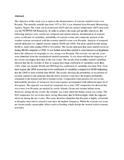| dc.description.abstract | The objective of this study was to analyze the characteristics of extreme rainfall events over
Rwanda. The monthly rainfall data from 1971 to 201 4 was obtained from Rwanda Meteorology
Agency, Kigali. The wind, sea level pressure (SLP) and sea surface temperature (SST) data used
was the NCEP/NCAR Reanalysis. In order to achieve the main and specific objectives, the
following analyses were current out; temporal and spatial analysis, determination of extreme
years, coefficient of variability, probability of extreme events and composite analysis of the
weather systems associated with the extreme rainfall events over Rwanda.
Analysis of temporal rainfall indicated two rainfall seasons namely MAM and OND. The peak
rainfall month during MAM is April while during OND is November. The results indicated that
more rainfall received during MAM compared to OND. It was further noted that rainfall is
concentrated over highlands hence the influence of orography is very strong over Rwanda.
The extreme wet and dry years were identified from the standardized rainfall anomalies. It was
observed that the frequency of dry events was higher than that of the wet events. The results
from monthly rainfall variability showed that the dry months of June to August have high
coefficient of variability more than 110% while wet months MAM and OND had low coefficient
of variability less than 50%. Over most region, the OND season has lower coefficient of
variability compared to MAM indicating that the OND is more reliable than MAM.
The results showing the probability of occurrence of extreme rainfall events indicates that the
below normal events have the highest probability compared to the normal and above normal
events. Composited wind patterns for wet events indicated the presence of strong low level
convergence accompanied with enhanced upper level divergence. The opposite was noted for
composite dry events. SST composites for showed that wet events over Rwanda are marked by
cooler Atlantic Ocean and warmer Indian ocean. However, during the dry events, the Atlantic
was warm while the Indian ocean was cooler. The SLP composites for wet events show strong
Mascarine and St Helena highs while the opposite observed during the dry events.
This study therefore identified that Rwanda is highly vulnerable to droughts since below normal
events have the highest frequency. While the extreme wet event are fewer usually catastrophic
effects such as flooding which disrupt the normal social economy activities. | en_US |


